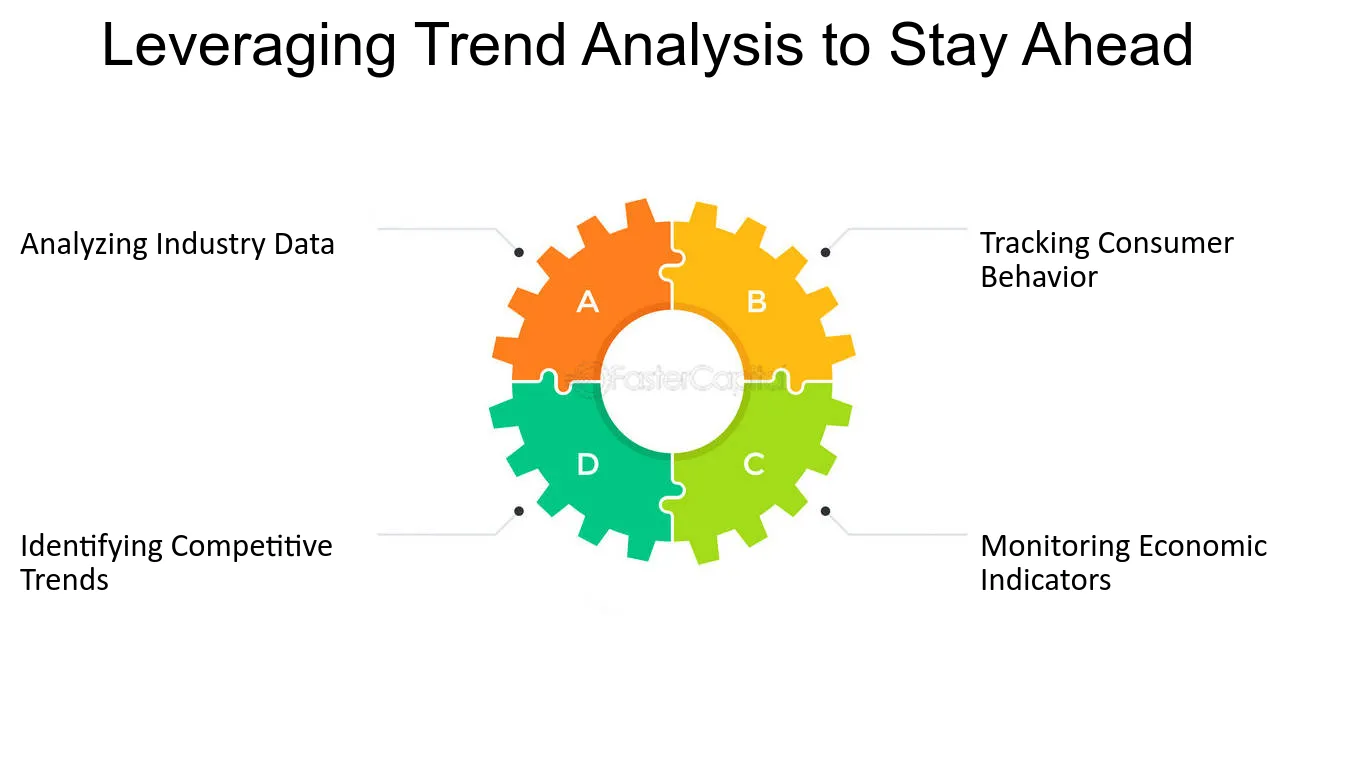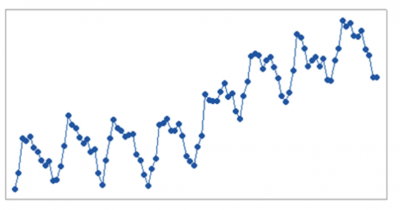Did you know that a study by McKinsey & Company found companies that leverage trend analysis techniques outperform their competitors by a whopping 30% in sales growth? With the constant changes in retail and e-commerce, failing to adapt is a recipe for failure. You need to stay ahead to survive.
That’s the power of understanding what your customers crave before they even know it themselves. But with so much data flying around, how do you cut through the noise and identify the trends that truly matter? The answer lies in mastering powerful trend analysis techniques. This blog post will equip you with the top 11 methods to unlock the secrets hidden within your market research data, propelling your retail or e-commerce business to new heights.
Understanding Trend Analysis

Source: FasterCapital
Trend analysis is the process of identifying and analyzing patterns and changes in data over time. In the context of market research, it’s a powerful tool for understanding consumer behavior, market dynamics, and predicting future trends. By employing various trend analysis techniques, businesses can gain valuable insights that inform strategic decision-making and propel them ahead of the competition.
Here’s how trend analysis techniques contribute to market research success:
-
Unveiling Customer Preferences: Trend analysis helps uncover evolving customer preferences and buying habits. By analyzing historical sales data, website traffic patterns, and social media conversations, businesses can identify what products or services are gaining traction and which ones are falling out of favor. This knowledge empowers them to tailor their offerings and marketing strategies to resonate with their target audience.
-
Forecasting Market Shifts: Market trends are constantly evolving, and trend analysis techniques equip businesses with the foresight to anticipate these shifts. By analyzing economic indicators, competitor activity, and social media sentiment, businesses can predict upcoming changes in consumer demand and market conditions. This allows them to adapt their strategies proactively, ensuring they remain relevant and competitive.
-
Optimizing Resource Allocation: Trend analysis empowers businesses to make data-driven decisions about resource allocation. By identifying emerging trends and prioritizing resources accordingly, businesses can maximize their return on investment and ensure they’re focusing their efforts on the areas with the highest potential for growth.
In essence, trend analysis techniques act as a compass, guiding businesses through the ever-changing landscape of the market. By harnessing the power of these techniques, businesses can gain a deeper understanding of their customers, anticipate future trends, and make informed decisions that drive success.
5 Trend Analysis Techniques for Market Research

Source: SMstudy
Having established the critical role of trend analysis in market research, let’s delve deeper and explore the various techniques that unlock valuable insights. Broadly, these techniques can be categorized into two main types:
- Quantitative Techniques: These methods rely on numerical data and statistical analysis to identify patterns and trends. They are ideal for uncovering objective trends in large datasets.
- Qualitative Techniques: These methods focus on understanding the “why” behind the data, drawing insights from open-ended responses, focus groups, and social media sentiment. They offer a deeper understanding of consumer motivations and opinions.
Now, let’s explore five powerful trend analysis techniques that can be leveraged for effective market research:
1. Time Series Analysis: Unveiling Patterns Across Time
Methodology: Time series analysis involves analyzing data points collected at regular intervals over time. This technique helps identify seasonal variations, cyclical patterns, and long-term trends in sales figures, website traffic, social media engagement, and other relevant metrics.
Benefits:
- Improved forecasting: By understanding historical patterns, businesses can make informed predictions about future market behavior.
- Inventory management: Identifying seasonal trends allows businesses to optimize inventory levels and avoid stockouts or overstocking.
- Campaign optimization: Analyzing campaign performance data over time helps identify the most effective strategies for future marketing efforts.
Industry Applications: Retail, e-commerce, finance, healthcare (analyzing disease outbreaks)
Example: A clothing retailer uses time series analysis to identify seasonal trends in clothing purchases. This allows them to ensure they have sufficient stock of winter jackets during peak season and avoid overstocking on summer wear during off-seasons.
2. Social Listening: Decoding Consumer Conversations
Methodology: Social listening involves monitoring online conversations about your brand, industry, and competitors across social media platforms and online communities. This technique helps understand customer sentiment, identify emerging trends, and uncover potential brand crises.
Benefits:
- Brand reputation monitoring: Identify and address negative feedback about your brand before it escalates.
- Product innovation: Analyze social media conversations to identify features and functionalities customers are requesting, informing product development.
- Competitive intelligence: Gain insights into competitor strategies and understand customer perception of your competitors’ products and services.
Industry Applications: All industries, especially those with a strong online presence (retail, food & beverage, travel)
Example: A social media management tool company uses social listening to understand customers’ frustrations with their current software. By analyzing these conversations, they identify features that require improvement and prioritize them in their product roadmap.
3. Text Analytics: Extracting Meaning from Unstructured Data
Methodology: Text analytics utilizes natural language processing (NLP) techniques to analyze large volumes of unstructured text data such as customer reviews, social media posts, and online forums. This allows businesses to extract insights into customer sentiment, opinions, and emerging trends.
Benefits:
- Improved customer satisfaction: Analyze customer reviews to identify areas for improvement and enhance the customer experience.
- Product development insights: Analyze customer feedback to understand what features are most valued and identify opportunities for product innovation.
- Topic modeling: Identify recurring themes and topics in online conversations, revealing emerging customer interests and concerns.
Industry Applications: All industries that deal with large volumes of customer feedback (retail, travel, healthcare)
Example: A travel company uses text analytics to analyze customer reviews of their vacation packages. This allows them to identify specific locations or amenities that consistently receive positive feedback, informing future marketing efforts.
4. Market Basket Analysis: Uncovering Hidden Relationships
Methodology: Market basket analysis, also known as association rule learning, involves analyzing customer purchase data to identify frequently purchased items together. This technique helps uncover hidden relationships between products and allows businesses to develop targeted marketing strategies.
Benefits:
- Upselling and cross-selling opportunities: Identify products frequently purchased together and recommend them to customers during the checkout process.
- Inventory management: Optimize product placement and bundling strategies based on purchase patterns.
- Product recommendation engines: Develop personalized product recommendations based on a customer’s past purchases.
Industry Applications: Retail, e-commerce, streaming services, subscription services, manufacturing, hospitality, financial Services
Example: A streaming service analyzes subscription data to identify which music genres are frequently paired with specific movie genres. Based on this insight, the service can curate personalized playlists or recommend movies based on a user’s music listening habits, creating a more engaging user experience.
5. SWOT Analysis: Identifying Strengths, Weaknesses, Opportunities & Threats
Methodology: SWOT analysis is a strategic planning framework that helps businesses evaluate their internal strengths and weaknesses (SW), and external opportunities and threats (OT). While not strictly a trend analysis technique, it incorporates trend analysis by considering how external trends might impact the business’s strengths, weaknesses, opportunities, and threats.
Benefits:
- Strategic decision-making: By understanding both internal and external factors, businesses can make informed decisions about product development, marketing strategies, and resource allocation.
- Adapting to change: Regularly conducting SWOT analyses helps businesses identify and adapt to emerging market trends and stay ahead of the competition.
Industry Applications: All industries
Example: A clothing company conducts a SWOT analysis. They identify their strength as high-quality, ethically sourced materials. A weakness is their limited online presence. An external opportunity is the growing market for sustainable clothing. A threat is the rise of fast-fashion competitors. Based on this analysis, the company can focus on building a stronger online presence to leverage the growing market for sustainable clothing, while mitigating the threat from fast-fashion competitors by emphasizing their ethical sourcing practices.
By effectively utilizing these five trend analysis techniques, businesses can gain a deeper understanding of their market, anticipate future trends, and make data-driven decisions that propel them towards success. Remember, the key lies in not relying on a single technique but combining them to paint a holistic picture of your market landscape. In the final part of this series, we’ll discuss best practices for implementing these techniques and maximizing the value they bring to your market research endeavors.
3 Quantitative Trend Analysis Techniques
Here are three powerful quantitative trend analysis techniques for market research:
#1 Time Series Analysis
- Description: Analyzes data points collected at regular intervals over time to identify patterns and trends.
- Application: Used to forecast future market behavior, optimize inventory levels, and evaluate the effectiveness of marketing campaigns over time.
- Benefit: Provides insights into historical patterns to make informed predictions about future market conditions and consumer behavior.
#2 Mann-Kendall Trend Test
- Description: A non-parametric statistical test to assess if a monotonic trend (upward or downward) exists in a time series dataset.
- Application: Useful for analyzing market research data that may not follow a normal distribution (e.g., customer satisfaction scores, website traffic over time). It helps identify if there’s a consistent increase or decrease over time.
- Benefit: Provides a relatively easy-to-understand approach to identify the direction (upward or downward) of a trend in your data, even if the data isn’t perfectly normal.
#3 ARIMA (Autoregressive Integrated Moving Average) Model
- Description: A statistical model used to forecast future values in a time series by considering past values of the data (autoregressive component), differencing the data to remove trends and seasonality (integrated component), and incorporating the forecast errors from previous predictions (moving average component).
- Application: Ideal for forecasting future sales figures, website traffic, or customer demand based on historical data patterns. It’s particularly useful for time series data that exhibits trends and seasonality.
- Benefit: Provides a powerful and statistically robust method for predicting future values in time series data, allowing businesses to proactively plan for changes in market conditions and customer behavior.
3 Qualitative Trend Analysis Techniques
Here are three powerful qualitative trend analysis techniques for market research:
#1 Focus Groups
- Description: Small, moderated discussions with a targeted group of participants to gain insights into their opinions, attitudes, and experiences related to a specific product, service, or market trend.
- Application: Used to understand customer needs and preferences, explore new product concepts, and gather feedback on marketing campaigns before launch.
- Benefit: Provides rich qualitative data that goes beyond numbers, offering valuable insights into the “why” behind customer behavior.
#2 Social Listening
- Description: Monitoring online conversations about your brand, industry, and competitors across social media platforms and online communities.
- Application: Used to identify emerging trends, understand customer sentiment, and uncover potential brand crises before they escalate.
- Benefit: Provides real-time insights into what people are saying about your brand and industry, allowing for proactive reputation management and trend identification.
#3 Expert Opinion Surveys
- Description: Gathering insights from industry experts, thought leaders, and market analysts on their perspectives regarding future trends and market developments.
- Application: Used to gain valuable foresight into potential disruptions, emerging technologies, and shifting consumer preferences.
- Benefit: Offers access to specialized knowledge and diverse industry perspectives, informing strategic decision-making for future market success.
Integrating Trend Analysis into Business Strategy

Source: LinkedIn
In today’s dynamic business landscape, staying ahead of the curve requires a proactive approach. Trend analysis, the art of identifying and analyzing patterns in data, offers a powerful tool to inform strategic planning and propel businesses towards success. Here’s how companies can integrate these valuable insights into their strategic roadmap:
- Define Strategic Objectives: Before diving into data analysis, clearly define your business objectives. What are your long-term goals? Are you aiming to expand into new markets, develop innovative products, or improve customer satisfaction? Having a clear vision will help identify relevant trends to analyze.
- Identify Data Sources: Depending on your objectives, gather data from various sources. Leverage internal data on sales figures, customer demographics, and website traffic. Utilize market research reports, industry publications, and social media analytics tools to capture external trends. Consider tools like the Palowise trends analysis to gauge consumer search behavior or social listening platforms like the Palowise platform to monitor online conversations.
- Choose the Right Techniques: Not all trends are created equal. Select the appropriate trend analysis technique based on your data and objectives. Quantitative techniques like time series analysis (using software like Excel or specialized forecasting tools) can help predict future sales based on historical data. Qualitative methods like focus groups (facilitated with tools like Lookback or UserTesting) offer valuable insights into customer motivations and preferences.
- Analyze and Interpret the Data: Once you have your data and chosen techniques, meticulously analyze it. Identify recurring patterns, emerging trends, and potential threats or opportunities. Tools like Tableau or Power BI can help visualize the data and uncover hidden relationships. Don’t just focus on the numbers; interpret the “why” behind the trends.
- Translate Insights into Action: The true power of trend analysis lies in its actionable insights. Use the identified trends to inform your strategic planning. Develop strategies to capitalize on opportunities, mitigate potential threats, and adapt to changing market dynamics. Consider using project management tools to track and prioritize strategic initiatives based on emerging trends.
- Continuously Monitor and Adapt: The business landscape is constantly evolving. Monitor the identified trends over time and stay updated on new developments. Don’t be afraid to adapt your strategies as new information emerges. Maintain a culture of data-driven decision making and leverage trend analysis as an ongoing process to ensure long-term business success.
By integrating these steps and utilizing the right tools, businesses can transform trend analysis from a reactive exercise to a proactive strategic advantage. By weaving insights from the future into their strategy, companies can make informed decisions, build resilience, and navigate the ever-changing currents of the market.
3 Powerful Tools to Integrate Trend Analysis Techniques into Business Strategy
The key to unlocking the full potential of trend analysis lies in selecting the right tools. These tools streamline the data collection, analysis, and visualization process, allowing businesses to gain actionable insights and integrate them seamlessly into their strategic planning. Here are five powerful options to consider:
-
SurveyMonkey: This popular platform facilitates gathering valuable customer insights through online surveys. Businesses can leverage SurveyMonkey to conduct market research, measure customer satisfaction, and understand evolving customer preferences – all crucial elements for identifying future trends.
-
Google Analytics 4 (GA4): GA4 offers a comprehensive suite of analytics tools for websites and mobile apps. It goes beyond traditional session-based data, providing insights into user journeys and customer behavior across platforms. GA4‘s advanced features like predictive analytics and custom funnels empower businesses to identify emerging trends and anticipate future customer actions.
-
Tableau: A leader in data visualization, Tableau transforms complex datasets into clear and insightful dashboards. Businesses can leverage Tableau to visualize trends, identify correlations between data points, and communicate insights effectively to stakeholders. This allows for data-driven decision making and strategic planning based on the revealed trends.
Beyond these options, consider Palowise as a powerful web and social media intelligence analytics platform. Palowise offers a comprehensive suite of tools for gathering data from various online sources, analyzing customer behavior and sentiment, and identifying emerging trends. Its user-friendly interface and advanced features make it a valuable asset for businesses seeking to integrate trend analysis into their strategic planning.
Remember, the right toolset depends on your specific needs and budget. By carefully selecting tools that complement your chosen trend analysis techniques and strategic objectives, you can ensure that your business is well-equipped to navigate an ever-changing market landscape.
2 Case Studies and Real-World Applications of Trend Analysis Techniques

Source: Flatworld Solutions
Here are two case studies showcasing how companies successfully implemented trend analysis techniques to gain valuable insights and achieve strategic goals:
Case Study #1: L’Oreal Tracking Social Media Sentiment for Product Development
- The Challenge: L’Oreal, a leading cosmetics company, faced a dynamic beauty landscape with evolving customer preferences. Staying ahead of the curve and understanding their target audience’s desires was crucial for maintaining market share. Traditional market research methods often lacked real-time insights into customer sentiment and emerging trends.
- Solution: L’Oreal implemented social listening techniques. They used social media monitoring tools to analyze online conversations on platforms like Twitter, Instagram, and beauty blogs. By analyzing the sentiment and content of these conversations, L’Oreal gained valuable insights into what customers loved about existing products, what features they desired, and what emerging trends were gaining traction.
- Outcomes: By identifying a surge in online discussions about natural and organic beauty products, L’Oreal was able to adapt their product development strategy. They launched new lines of organic makeup and skincare products, catering to the growing customer demand for natural ingredients and eco-friendly practices. This data-driven approach allowed L’Oreal to stay ahead of the curve and deliver products that resonated with their target audience.
- Lessons Learned: Social listening provides a real-time window into customer sentiment and emerging trends. By actively monitoring online conversations, businesses can gain valuable insights that inform product development, marketing strategies, and overall brand positioning.
Case Study #2: Netflix Optimizing Content Strategy with Machine Learning
- The Challenge: Streaming giant Netflix faced the challenge of maintaining subscriber growth in a crowded market. Predicting which content would resonate with their diverse audience base was crucial for their success. Traditional methods relied heavily on historical viewing data and might not capture the nuances of evolving viewer preferences.
- Solution: Netflix implemented machine learning algorithms to analyze vast amounts of user data. This data included viewing history, search queries, and ratings. By analyzing these patterns, the algorithms predicted which content viewers were most likely to watch and enjoy. Additionally, they analyzed social media conversations and pop culture trends to identify emerging themes and genres that might attract new subscribers.
- Outcomes: Netflix’s data-driven approach led to the production of highly successful original series like “Stranger Things” and “House of Cards”. By leveraging machine learning and trend analysis techniques, they were able to predict viewer preferences with greater accuracy, reduce the risk of expensive flops, and curate a content library that kept subscribers engaged.
- Lessons Learned: Advanced data analysis techniques like machine learning can unlock powerful insights from vast datasets. Combining historical data with real-time trend analysis allows businesses to anticipate customer preferences and optimize their strategies for long-term success.
3 Challenges in Trend Analysis Techniques and How to Overcome Them

Source: iSixSigma
While trend analysis offers valuable insights, businesses can encounter roadblocks during implementation. Here are three common challenges and practical solutions to navigate them:
Challenge #1: Data Quality and Availability: Low-quality or incomplete data can lead to misleading results. Businesses might lack historical data or struggle with data inconsistencies.
- Solution: Implement data quality checks to ensure accuracy and consistency. Consolidate data from various sources and utilize data cleansing techniques to remove errors and outliers. Invest in data management solutions to organize and centralize data for easy access and analysis.
Challenge #2: Selecting the Right Techniques: Choosing the wrong trend analysis technique can lead to misinterpretations. The chosen technique should be appropriate for the data type and the specific trends you’re looking to identify.
- Solution: Clearly define your objectives and the type of data you have available. Research and understand the strengths and limitations of different trend analysis techniques (e.g., time series analysis for identifying long-term trends, social listening for understanding customer sentiment). Seek guidance from data analysts or statisticians to ensure you’re selecting the most suitable methods.
Challenge #3: Difficulty Interpreting Results: Extracting actionable insights from complex data analysis can be challenging. Numbers and charts don’t always paint the whole picture.
- Solution: Focus on the “why” behind the trends. Combine quantitative data with qualitative research (e.g., focus groups) to understand the underlying reasons for the observed patterns. Present your findings in clear and concise visuals that are easy for stakeholders to understand. Communicate the implications of your analysis and translate trends into actionable recommendations for your business strategy.
The Future of Trend Analysis in Market Research

Source: Global Subscriber Base
The world of market research is undergoing a significant transformation, fueled by the growing influence of Artificial Intelligence (AI) and Big Data. Here are two emerging trends that will likely shape the future of trend analysis:
Trend #1: AI-powered Predictive Analytics
- Description: AI algorithms are continuously evolving, offering the ability to analyze vast amounts of data and identify not just existing trends but predict future ones. These algorithms can process data from diverse sources, including social media conversations, customer reviews, and search engine queries, to uncover hidden patterns and anticipate emerging customer needs and preferences.
- Impact: This will revolutionize market research by enabling businesses to proactively adapt their strategies to future market shifts. Imagine predicting what products consumers will want before they even know they want them! Businesses can use this foresight to develop innovative products and services, optimize marketing campaigns, and gain a competitive edge.
Trend #2: Real-time Trend Analysis with Big Data
- Description: The ever-increasing volume of data generated daily – social media posts, sensor data, customer interactions – represents a treasure trove of real-time insights. Big Data analytics tools are becoming more sophisticated, allowing businesses to analyze and interpret this data in real-time.
- Impact: This shift from historical data analysis to real-time insights will transform market research by enabling businesses to monitor and respond to trends as they unfold. Imagine identifying a sudden surge in negative customer sentiment online and immediately taking corrective action to address the issue. Real-time trend analysis empowers businesses to be more agile and responsive to market dynamics, ultimately leading to improved customer satisfaction and brand reputation.
These are just a few examples of how AI and Big Data are reshaping the future of trend analysis. By embracing these innovations, businesses can unlock a world of possibilities, gaining a deeper understanding of their target markets and propelling themselves towards long-term success.
Navigate the Evolving Landscape with Palowise – Your Trend Analysis Partner
In today’s dynamic market environment, staying ahead of the curve is no longer an option, it’s a necessity. By harnessing the power of trend analysis techniques, businesses can unlock valuable insights from data, identify emerging customer preferences, and anticipate future market shifts. This empowers them to make data-driven decisions, develop innovative products and services, and ultimately achieve long-term success.
As we’ve explored, various quantitative and qualitative techniques exist, from time series analysis to social listening. Choosing the right technique depends on your specific goals and data type. However, the key lies in not relying on a single method, but combining them to paint a holistic picture of your market landscape.
The future of trend analysis is bright, with AI and Big Data poised to revolutionize market research. Imagine predicting customer needs before they even arise or responding to emerging trends in real-time! By embracing these innovations, businesses can gain a significant competitive edge.
Palowise can be your partner in navigating this evolving landscape. Our powerful web and social media intelligence platform offers a comprehensive suite of tools to gather data, analyze trends, and extract actionable insights. With Palowise, you can:
- Monitor online conversations: Track brand sentiment, identify emerging trends, and uncover potential crises before they escalate.
- Gain customer insights: Analyze customer reviews and social media interactions to understand their needs, preferences, and pain points.
- Predict future trends: Leverage AI-powered analytics to anticipate market shifts and make informed strategic decisions.
Don’t get left behind! Empower your business with the power of trend analysis. Visit Palowise today and schedule a free demo to see how our platform can help you unlock the future of your market research.


